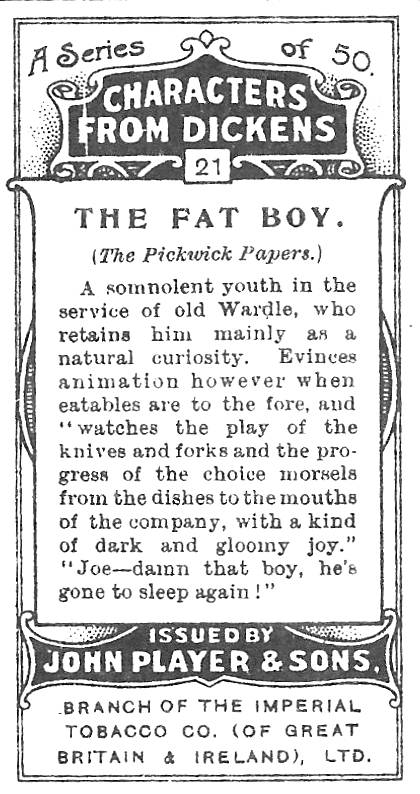

The Fat Boy by J. Clayton Clarke ("Kyd") for the watercolour series (1910): reproduced on John Player cigarette card no. 21: Ninety-two Characters from Dickens: The Pickwick Papers. 2 ½ inches high by 1 ¼ inches wide (6.3 cm high by 3.3 cm wide). [Click on the images to enlarge them.]
THE FAT BOY (The Pickwick Papers)
A somnolent youth in the service of old Wardle, who retains him mainly as a natural curiosity. Evinces animation however when eatables are to the fore, and "watches the play of of the knives abd forks and the progress of choice morsels from the dishes to the mouths of the compoany, with a kind of dark and gloomy joy." “Joe — damn that boy, he's gone to sleep again!” [Verso of Card No. 21]
Commentary: Joe, Old Wardle's Sleepy Page, in Uniform

Left: Kyd's later study for Joe in a coaching uniform, The Fat Boy.
Those of Kyd's turn-of-the-century readers familiar with the original 1836-37 Phiz illustrations for The Pickwick Papers would instantly have recognized in Player's Cigarette Card No. 21 the likeness of Mr. Wardle's uniformed page, the grossly overweight adolescent who is a a minor but recurring comic character in Dickens's first novel. The omnivorous Joe, Mr. Wardle's somnolent house-servant at Manor Farm in Dingley Dell, Kent, appears in Chapters 4-9, 28, 30, 54, and 56, and in one of the two illustrations for the last monthly instalment (November 1837): Mary and The Fat Boy (Chapter 54). The running gag of Joe's habitual sleepiness does not prepare us for Dickens's ultimately revealing his libidinous nature in his final appearance as stimulated by more than a nice pork pie.
Passage Suggested by the Image and the Verso Commentary for Card No. 21
The young Misses Wardle were so frightened, that Mr. Trundle was actually obliged to hold one of them up in the carriage, while Mr. Snodgrass supported the other; and Mr. Wardle’s sister suffered under such a dreadful state of nervous alarm, that Mr. Tupman found it indispensably necessary to put his arm round her waist, to keep her up at all. Everybody was excited, except the fat boy, and he slept as soundly as if the roaring of cannon were his ordinary lullaby.
‘Joe, Joe!’ said the stout gentleman, when the citadel was taken, and the besiegers and besieged sat down to dinner. ‘Damn that boy, he’s gone to sleep again. Be good enough to pinch him, sir — in the leg, if you please; nothing else wakes him — thank you. Undo the hamper, Joe.’
The fat boy, who had been effectually roused by the compression of a portion of his leg between the finger and thumb of Mr. Winkle, rolled off the box once again, and proceeded to unpack the hamper with more expedition than could have been expected from his previous inactivity. [The Household Edition, Chapter IV, "A Field-Day and Bivouac — More New Friends; And an Invitation to the Country," 27]
The Scenes with The Fat Boy in Various Editions (1837-1910)



Left: Harry Furniss seems to have had Phiz's original engraving in mind as he emphasized Joe's awkward lasciviousness in Mary and the Fat Boy: The fat boy, with elephantine playfulness, stretched out his arms to ravish a kiss Mary and The Fat Boy (1910). Centre: Phiz's Household Edition woodcut reworks his original 1837 steel engraving as "I say, how nice you look!" (1874). Right: Sol Eytinge, Jr.'s Diamond Edition Vol. 1 illustration The Fat Boy (1867) makes Joe a grossly overweight child. [Click on the images to enlarge them.]



Left: Phiz's original engraving for the conclusion of the serial novel, The Fat Boy Awake Again (substituted in November 1837 for Chapter VIII). Centre: Thomas Nast's American Household Edition woodcut reworks Phiz's 1837 steel engraving as "Will you have some of this?" said the Fat Boy (1873). Right: Harry Furniss's version of the scene between Mary and the suddenly amorous Joe, Mary and the Fat Boy (1910). [Click on the images to enlarge them.]
Scanned images and text by Philip V. Allingham. [You may use these images without prior permission for any scholarly or educational purpose as long as you (1) credit the person who scanned the images, and (2) link your document to this URL in a web document or cite the Victorian Web in a print one.]
Bibliography
The Characters of Charles Dickens pourtrayed in a series of original watercolours by “Kyd.” London, Paris, and New York: Raphael Tuck & Sons, nd.
Davis, Paul. Charles Dickens A to Z: The Essential Reference to His Life and Work. New York: Facts On File and Checkmark Books, 1998.
Dickens, Charles. The Posthumous Papers of the Pickwick Club. Illustrated by Robert Seymour, Robert Buss, and Phiz. London: Chapman and Hall, November 1837. With 32 additional illustrations by Thomas Onwhyn (London: E. Grattan, April-November 1837).
_____. Posthumous Papers of the Pickwick Club. Illustrated by Sol Eytinge, Jr. The Diamond Edition. 14 vols. Boston: Ticknor & Fields, 1867. Vol. 1.
_______. Posthumous Papers of the Pickwick Club. Illustrated by Thomas Nast. The Household Edition. 16 vols. New York: Harper and Brothers, 1873. Vol. 4.
_______. Posthumous Papers of the Pickwick Club. Illustrated by Hablot Knight Browne ('Phiz'). The Household Edition. 22 vols. London: Chapman and Hall, 1874. Vol. 6.
_______. Posthumous Papers of the Pickwick Club. Illustrated by Harry Furniss. The Charles Dickens Library Edition. 18 vols. London: Educational Book, 1910. Vol. 2.
Hammerton, J. A. The Dickens Picture-Book. London: Educational Book Co., 1910.
Johnannsen, Albert. "The Posthumous Papers of The Pickwick Club." Phiz Illustrations from the Novels of Charles Dickens. Chicago: University of Chicago Press; Toronto: The University of Toronto Press, 1956. 1-74.
Created 7 January 2015
Last updated 13 July 2025